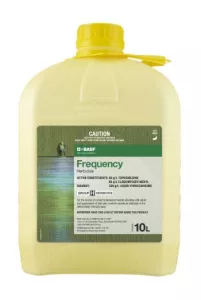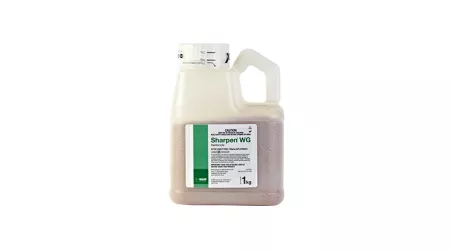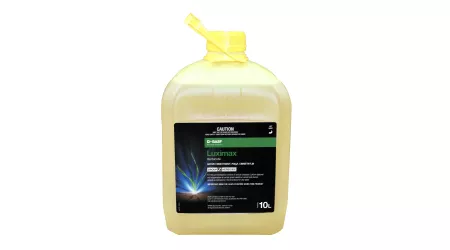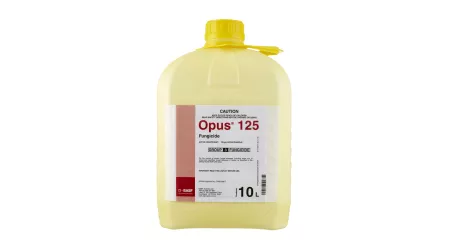Take a look at Frequency's fine-tune tank mixes video below!
Key benefits
- Versatile and highly effective Group 27 chemistry
- Excellent control of the most hard-to-manage broadleaf weeds
- The freedom to choose the most appropriate second active
- The flexibility to dial up tank-mix partners’ rates
- Favourable plantbacks to optimise crop rotations
How it works
-
Efficacy
Frequency is a contact herbicide which provides excellent control of a wide range of broadleaf weeds, including hard to kill weeds such as fleabane. Target weeds will show symptoms in 3–7 days and will usually die in 14–21 days. BASF recommends applying Frequency with a tank-mix partner such as bromoxynil or MCPA, which can be ‘dialled up’ in the mix according to the size and spectrum of the target weeds. Choosing tank-mix partners from different MOA groups can also help overcome resistance issues.
-
Mode of action
Frequency’s active ingredient, topramezone, has a Group 27 mode of action – it is an HPPD inhibitor (a “bleacher”).
-
Compatibility
Frequency is physically compatible with Ally*, Associate*, Agritone* 750 and LVE, Axial*, Bromicide* 200, bromoxynil, Flight* EC, MCPA (LVE), metsulfuron, Jaguar*, Paragon* Xtra, Sencor* 480 SC, Tigrex* and Topik* 240 EC. Frequency is also physically compatible with Easy N* liquid fertiliser, but application of that mix may result in increased crop effect. Trials have shown mixtures with picolinofen or diflufenican can cause foliar burn without affecting crop yield.
-
Plantbacks
Frequency has very favourable minimum plantback periods. Check the label of any product mixed with Frequency® Herbicide to determine any plant back periods or restrictions on use.
6 weeks: wheat, barley, maize.
4 months: canola, cotton, chickpeas, faba beans, field peas, lentils, lupins, mungbeans, safflower, sorghum, sunflowers. -
Suppression
Seed-set in wild oats in northern NSW and Queensland cropping zones where Avena sterilis is dominant in the targeted population.
-
Application method
Ground application only.
Use an appropriate tank-mix partner at a rate suited to the weed spectrum & size.
Add Hasten at 1%.
Ensure good coverage with medium spray quality using 80–150 L/ha water.
Do not apply to stressed crops.
Crop suitability
-
Barley
BiforaBindweed / buckwheatCapeweedCharlockDead nettleFleabaneFumitory (Fumaria spp.)PimpernelShepherd's purseSow thistle / Milk thistleStinging nettleSubterranean cloverTares / vetchTurnip weedWild oats / volunteer oatsWild radishWireweed -
Wheat
BiforaBindweed / buckwheatCapeweedCharlockDead nettleFleabaneFumitory (Fumaria spp.)PimpernelShepherd's purseSow thistle / Milk thistleStinging nettleSubterranean cloverTares / vetchTurnip weedWild oats / volunteer oatsWild radishWireweed -
Wheat (Durum)
BiforaBindweed / buckwheatCapeweedCharlockDead nettleFleabaneFumitory (Fumaria spp.)PimpernelShepherd's purseSow thistle / Milk thistleStinging nettleSubterranean cloverTares / vetchTurnip weedWild oats / volunteer oatsWild radishWireweed
Questions and Answers from the Field
-
How do I get rid of charlock?
To get rid of charlock, use Frequency, a selective herbicide in a tank mix with bromoxynil which provides excellent control of a wide range of broadleaf weeds, including hard to kill weeds such as charlock. Frequency adds a new dimension to selective weed control as it’s the first post-emergent Group 27 herbicide that isn’t locked into partner chemistry so that you can fine-tune the chemistry and rate of the tank-mix partner to find your perfect Frequency to get rid of charlock.
-
How do I permanently get rid of thistle weeds?
It’s not possible to permanently get rid of thistle weeds, such as sow thistle and milk thistle, but it’s ideal to use a selective herbicide such as Frequency to control thistle weeds in wheat and barley crops. Frequency offers excellent control of hard-to-control thistle weeds with its versatile new group 27 chemistry. Always refer to the label and choose the tank mix partner and rate that suits your situation best.
-
How do I permanently kill bindweed?
It’s not possible to permanently get control of bindweed (also known as buckwheat), but it’s ideal to use a selective herbicide such as Frequency to control bindweed. Frequency offers excellent control of hard-to-control bindweed with its versatile new group 27 chemistry.
-
How do you control fumitory, shepherd’s purse, turnip weed, wireweed, vetch, deadnettle and fleabane?
Frequency is a powerful herbicide that can control tough weeds such as fumitory, shepherd’s purse, turnip weed, wireweed, vetch, deadnettle and fleabane. Frequency offers excellent control of hard-to-control weeds with its versatile new group 27 chemistry.
-
How do you get rid of wild oats?
To get rid of wild oats, use Frequency, a powerful herbicide that controls a wide range of hard-to-control broadleaf weeds, including wild oats. Frequency offers excellent suppression of wild oats in northern New South Walse and Queensland with its versatile new group 27 chemistry.
-
What do you spray barley with?
Barley crops can be sprayed with Frequency, a powerful herbicide used to control hard-to-control broadleaf weeds. Frequency adds a new dimension to selective weed control and is an effective herbicide to spray barley with.
-
What chemical kills wild radish?
Frequency is a powerful herbicide with chemicals that kills wild radish in barley and wheat crops. Frequency offers excellent control of hard-to-control weeds such as wild radish with its versatile new group 27 chemistry.
-
What is the active ingredient in Frequency?
The active ingredients in Frequency herbicide are 60 g/L Topramezone, 60 g/L Cloquintocet-mexyl and 320 g/L Liquid hydrocarbons.




